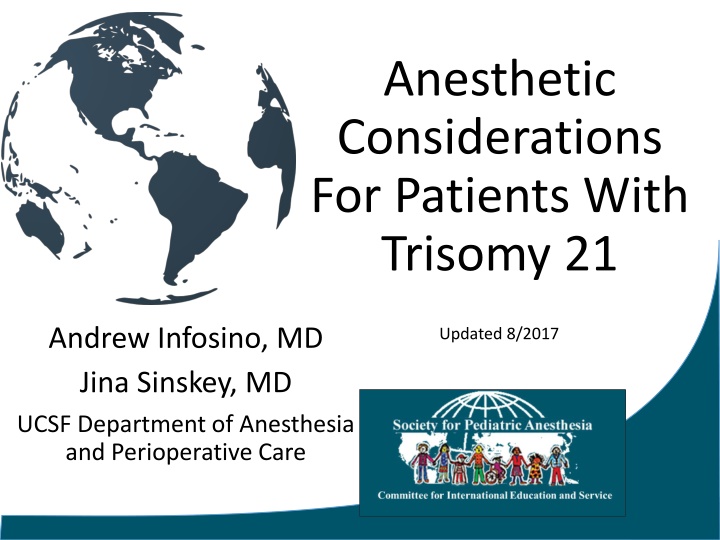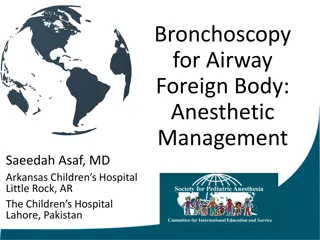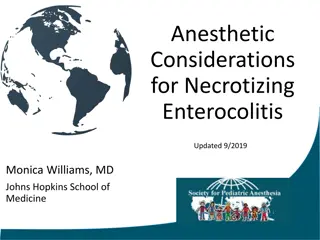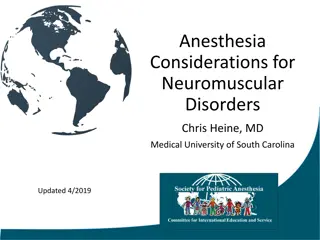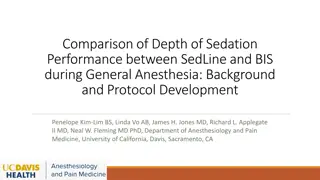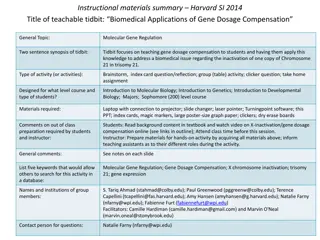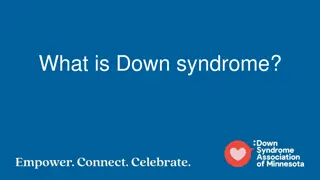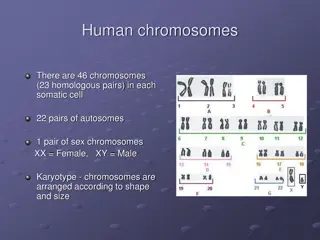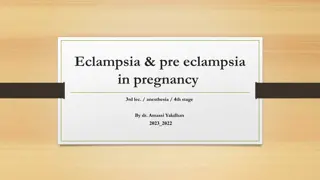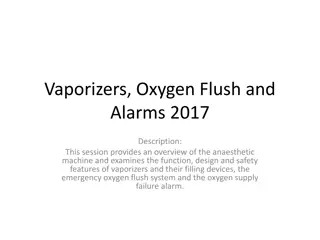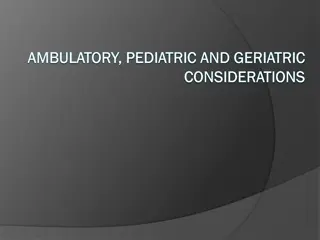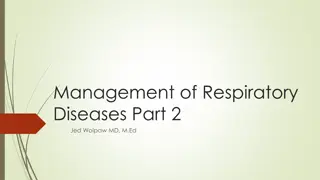Anesthetic Considerations for Patients with Trisomy 21
This informative content covers various aspects related to anesthetic considerations for patients with Trisomy 21, including the incidence, major risk factors, characterizing features, and key areas for assessment and management. Trisomy 21, also known as Down syndrome, is a chromosomal abnormality affecting approximately 1 in 700 newborns in the US. The material discusses the different types of Trisomy 21, risk factors associated with advanced maternal and paternal age, and common features such as mental retardation, short stature, obesity, simian crease, and hypotonia.
Download Presentation

Please find below an Image/Link to download the presentation.
The content on the website is provided AS IS for your information and personal use only. It may not be sold, licensed, or shared on other websites without obtaining consent from the author.If you encounter any issues during the download, it is possible that the publisher has removed the file from their server.
You are allowed to download the files provided on this website for personal or commercial use, subject to the condition that they are used lawfully. All files are the property of their respective owners.
The content on the website is provided AS IS for your information and personal use only. It may not be sold, licensed, or shared on other websites without obtaining consent from the author.
E N D
Presentation Transcript
Anesthetic Considerations For Patients With Trisomy 21 Andrew Infosino, MD Jina Sinskey, MD UCSF Department of Anesthesia and Perioperative Care Updated 8/2017
Disclosures None
Learning Objectives Indicate the incidence and major risk factor for having a child with trisomy 21 Describe characterizing features of patients with trisomy 21 List key areas for preoperative assessment in patients with trisomy 21 Describe the major issues regarding intraoperative management of patients with trisomy 21
Incidence of Trisomy 21 Most prevalent chromosomal abnormality worldwide Occurs in approximately 1 in 700 newborns in the US 6,000 infants born with trisomy 21 annually in the US Estimated > 400,000 individuals with trisomy 21 currently living in the US
Trisomy 21 Extra copy of chromosome 21 Image: U.S. Department of Energy Human Genome Program. [Public domain], via Wikimedia Commons
Types of Trisomy 21 > 95%: Non-disjunction (extra copy of chromosome 21 in every cell) 4%: Translocation (additional full or partial copy of chromosome 21 attached to another chromosome, usually chromosome 14) 1%: Mosaic trisomy 21 (extra chromosome 21 is present in some, but not all cells)
Risk Factors for Trisomy 21 Advanced maternal age is the major risk factor The risk of having a child with trisomy 21 increases in a linear fashion with advancing maternal age until age 30, then increases exponentially thereafter
Risk Factors for Trisomy 21 Advanced paternal age may contribute to a small increase in risk Environmental factors not shown to increase risk
Characterizing Features Mental retardation: very mild to severe Short stature Obesity Simian crease Hypotonia Image: By WurdBendur (Own work) [GFDL (http://www.gnu.org/copyleft/fdl.html) or CC BY-SA 4.0-3.0-2.5-2.0- 1.0 (http://creativecommons.org/licenses/by-sa/4.0-3.0-2.5-2.0-1.0)], via Wikimedia Commons
Craniofacial Abnormalities Microbrachycephaly Epicanthal folds Oblique palpebral fissures Small and low-set ears Macroglossia Microdontia Mandibular hypoplasia Broad, flat nose By Vanellus Foto (Own work) [GFDL (http://www.gnu.org/copyleft/fdl.html) or CC BY-SA 3.0 (http://creativecommons.org/licenses/by-sa/3.0)], via Wikimedia Commons
Trisomy 21: Associated Conditions Significant hearing loss (75%) Obstructive sleep apnea (50-80%) Ophthalmic disorders (60%) Congenital heart disease (50%) Atlanto-axial instability (20%) Gastrointestinal atresias (12%) Hypothyroidism (5-10%) Leukemia (1%)
Congenital Heart Disease Congenital heart defects in patients with trisomy 21 include: Atrioventricular septal or AV canal defects (45%) Ventricular septal defects (35%) Secundum atrial septal defects (8%) Patent ductus arteriosus (7%) Tetralogy of Fallot (4%)
Common Surgical Procedures Eye exam under anesthesia Tonsillectomy and adenoidectomy for OSA Myringotomy tubes Repair of congenital cardiac defects Repair of intestinal atresia Pull-through for Hirschsprung s Disease
Anesthesia Risk Children with trisomy 21 have a higher frequency of complications associated with general anesthesia than the general population Trisomy 21 patients tend to have more URIs Anesthetic complications include bradycardia, airway obstruction, difficult intubation, bronchospasm, post-intubation croup
Minimizing Anesthesia Risk Consider combining surgical procedures under one anesthetic Thorough preoperative evaluation of these patients is essential
Anesthetic Risk: Cardiac Important to assess the cardiac status of all patients with trisomy 21, even for non- cardiac surgery Trisomy 21 patients with congenital heart disease should have a thorough preoperative cardiac evaluation - Functional status assessment - Physical exam - EKG - Echocardiogram
Anesthetic Risk: Cardiac Assessing Cardiac Risk: Severity of the lesion Status of the repair Need for subacute bacterial endocarditis (SBE) prophylaxis Presence of shunting Presence of pulmonary hypertension
Anesthetic Risk: Pulmonary Hypertension Patients with trisomy 21 have an increased incidence of pulmonary hypertension Pulmonary hypertension may be related to congenital heart disease, obstructive sleep apnea, pulmonary hypoplasia and reduced nitric oxide bioavailability
Atlanto-Axial Instability Excessive movement between the atlas (C1) and axis (C2) Present in 20% of trisomy 21 patients Assess all trisomy 21 patients for atlanto-axial instability with history and physical exam Increased risk for subluxation and neurologic damage Limit neck mobility peri-operatively in all trisomy 21 patients
Atlanto-Axial Instability Consider preoperative radiologic assessment only in patients with pain or neurological symptoms with neck flexion or extension Cervical spine films in neutral, flexion and extension If radiographic evidence of atlanto-axial instability ( 5 mm between C1-C2), refer to neurosurgery or orthopedic surgery
Obstructive Sleep Apnea Due to upper airway obstruction at multiple sites Physical exam: macroglossia, mandibular hypoplasia, adenotonsillar hypertrophy, hypotonia, airway malacia, subglottic stenosis Worsened by obesity
Intraoperative Anesthesia Management All trisomy 21 patients are prone to bradycardia, especially during induction with sevoflurane Have atropine or glycopyrrolate readily available (may need to give IM if no IV) Vascular access can be difficult, may need ultrasound Some patients with trisomy 21 have hypoplastic or abnormal radial arteries
Airway Management Difficult mask ventilation Oral airway or laryngeal mask airway may help during induction and emergence Minimize neck flexion and extension during laryngoscopy and surgery Stabilize neck when moving or positioning Subglottic stenosis: may need smaller endotracheal tube than expected for age
Intraoperative Cardiac Management Patients with congenital heart disease (CHD) may require SBE prophylaxis Severe or uncorrected CHD: Consider anesthesiologists with expertise in pediatric cardiac anesthesia Significant pulmonary hypertension Minimize hypoxia Consider sildenafil Consider inhaled nitric oxide
Postoperative Management Extubate awake rather than deep May need oral or nasal airway Carefully titrate and minimize long acting opioids If obstructive sleep apnea, consider overnight admission or ICU stay Alert all providers of the potential for atlanto- axial instability
References References National Down Syndrome Society Website. http://www.ndss.org/Down- Syndrome https://www.pediatricheartspecialists.com/blog/55-down-syndrome-and- congenital-heart-disease http://pediatrics.aappublications.org/content/pediatrics/128/2/393.full.pdf Lewanda AF, et al. Preoperative evaluation and comprehensive risk assessment for children with Down syndome. Paediatr Anaesth, 2016; 26: 356 362 Borland LM, Colligan J, Brandom BW. Frequency of anesthesia-related complications in children with Down syndrome under general anesthesia for noncardiac procedures. Pediatric Anesthesia 2004; 14:733-738 Roodman S, Bothwell, M and Tobias, JD. Bradycardia with sevoflurane induction in patients with trisomy 21. Pediatric Anesthesia, 2003; 13: 538 540. Hamilton J, Yaneza MMC, Clement WA and Kubba H. The prevalence of airway problems in children with Down s syndrome. International Journal of Pediatric Otorhinolaryngology, 2016; 81:1-4.
